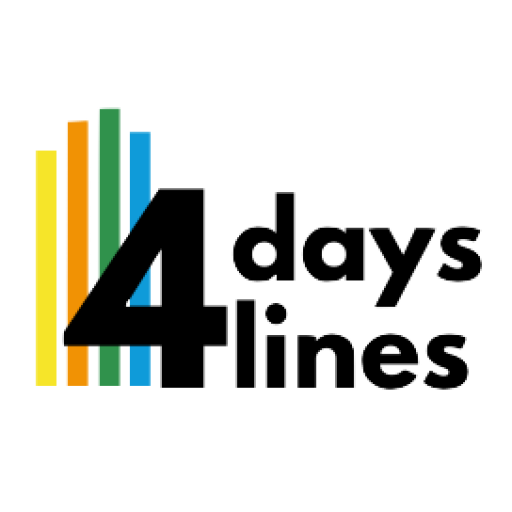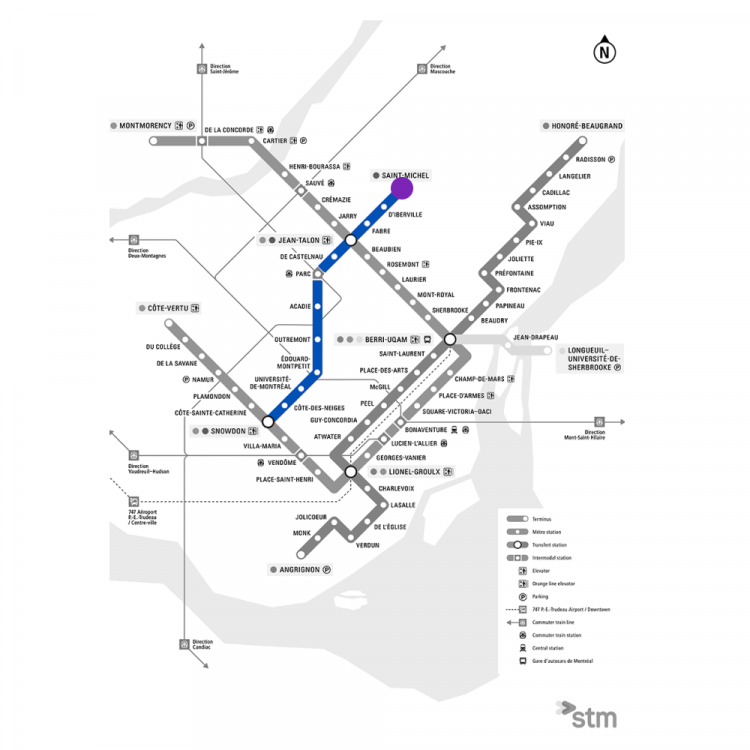Located in Villeray–Saint-Michel–Parc-Extension, Saint-Michel Metro is the eastern terminus of the blue line (for now). Points of interest around the station include a nursing home (CHSLD Joseph-François-Perrault), daycares, and elementary and high schools, all in the middle of a highly residential and highly multicultural neighborhood.
Station Layout
Saint-Michel Metro fits two of the obstacles that we have identified in Montreal’s metro stations and explained in our most recent video, “One-Sided Coin” and “Limbo Station” (or find out about them by reading a detailed article about our audit). Its layout is similar to Parc and Edouard-Montpetit, and we encourage you to read those spotlights to better understand how inconsistent escalator implementation can impact trip seamlessness and station accessibility.
As frustrating as they are, the head-scratching situations which exist at these stations are crucial examples displaying the importance of thinking about end-to-end accessibility. This is especially true in a terminal station like Saint-Michel, where seamless access to the trains establishes seamless access to the entire metro system.
Dealing with Inequitable Connectivity
Two of the most important facets of transit planning involve thinking about who the users will be and the destinations they will need to, or be able to, reach. As the city of Montreal gears up for a revamped transportation and mobility plan for the next 30 years, these are important elements to keep in mind and to put into context. The Saint-Michel station and this area’s place in the city’s transit system goes beyond physical accessibility. We have in the past discussed the financial accessibility of transit. This station spotlight is an opportunity to expand on these ideas.

Based on 2016 Census data, neighborhoods in Villeray–Saint-Michel–Parc-Extension have some of the lowest median total household income out of all of Montréal boroughs.
Numerous studies have shown that lower income citizens tend to use public transit more often than higher income citizens. For much of the population that uses public transit, access to an efficient and convenient mode of transportation that can connect you to most of the city has the potential to provide a huge amount of opportunity. Whether it is for school, for a job, for entertainment, or even to have the ability to make a choice about where to live, access to public transit is essential, especially for low income groups who usually don’t drive their own personal vehicles for commuting or for essential trips. Yet, according to a recent analysis of 8 Canadian metropolitan regions, while many low income neighborhoods are well-connected to transit, a significant amount of the lower-income groups in these cities are vulnerable to “transit poverty,” which can result in less job opportunities, political and public participation, and reduced access to entertainment and services.
Whether it is for school, for a job, for entertainment, or even to have the ability to make a choice about where to live, access to public transit is essential, especially for low income groups who usually don’t drive their own personal vehicles for commuting or for essential trips.
The problem of inequitable transit accessibility is further exacerbated when fare prices are high in addition to service being incomplete or inefficient. Both researchers and advocacy groups have brought attention to fare inequality. From an income standpoint, even though a monthly pass may be less expensive overall, the high upfront cost ($90.50) may be an obstacle to lower income populations, making it hard for them to benefit from the discount that it represents as opposed to buying 4 weekly passes ($28 each, or $112 for the month). Some cities, such as Washington D.C., have restructured their fare schedules to account for this potential obstacle, while others, such as San Francisco and Calgary, go a step further and offer discounted fares for low-income transit users. Mouvement pour un transport public abordable (MTPA), a Montreal-based advocacy group, has called for a similar measure to be put in place in the city, but the STM has shown no sign of moving in that direction, especially given the current budget deficit it finds itself in.
Costs and Benefits of the Blue Line Extension
So what is being done for the vulnerable residents in Montreal?
The northern section of the blue line has been in the news lately as the city of Montreal and STM have started work on an extension to the line. The planned extension project will take the Blue Line at least five stations past Saint-Michel, all the way into Anjou. However, this project has been controversial and has attracted some criticism. The problem with this extension is that it does little to increase connectivity for this area of Montreal. While the new stations will allow more people to get onto the metro, it will still be very hard to get to downtown from the Blue Line, especially if trying to reach a destination on the Green Line. The STM is planning a Bus Rapid Transit service between the future Pie-IX station on the Blue Line and the current Green Line Pie-IX station. However, this will still require getting on and off the metro to get to the bus, to then getting back on the metro on the Green Line.

In a community ideation session conducted at Anjou by a local environmental group, MtlGreen, the residents expressed more interest in the Pink Line over the Blue Line extension. The proposed Pink Line would increase metro connectivity and access to various points of interests all the while reducing the number of transfers required. Given the high price tag associated with the Blue Line extension, residents of this area called for a more frequent bus service towards the Green Line, towards Saint Michel station on Blue Line, and Jean Talon station on Orange Line. Many of these residents used buses or their own cars, but expressed high interest in using buses if the frequency was increased to the aforementioned key stations to reduce transfers. Instead, bus service has been reduced by 3.5% this year as the STM’s financial struggles continue.

The Project Moving Forward
The expensive bill on this project has led to the project management committee scrambling for cost-cutting solutions, including moving and reconfiguring the Anjou terminal, reducing the number of elevators that will be installed, and even considering eliminating an entire station from the extension. With the cost-cutting measures applied, the $5.7 billion extension project should be in service starting in early 2029. But what accessibility infrastructure may have been eliminated from such cost-cutting? What does the elevator reduction represent concretely? How might a station reconfiguration impact the seamlessness of the trip? Such decisions, de-prioritizing universal accessibility, lead to infrastructure choices which may turn into barriers. We have identified five structural barriers in our audit of Montreal’s metro system, and these cost-cutting decisions in the Blue Line extension can exacerbate existing inaccessibility. For such a long-term and cost-intensive infrastructure project, good execution is imperative, and public consultation is extremely important. What other solutions are provided in the meantime? There are many questions to be answered, and in the meantime service reductions and construction blockages may exclude many from the connectivity that the STM is meant to provide.
But what accessibility infrastructure may have been eliminated from such cost-cutting? What does the elevator reduction represent concretely? How might a station reconfiguration impact the seamlessness of the trip? Such decisions, de-prioritizing universal accessibility, lead to infrastructure choices which may turn into barriers.
Montreal’s upcoming new mobility plan will make a concerted and explicit effort to address equitable access to the city through transit. There are many lessons to be learned from the current state of the Blue Line extension project which should be implemented into future transit planning. Hopefully, the project will be a successful first step towards a more equitably connected metropolitan area that responds directly to the needs and wants of the most vulnerable groups.


